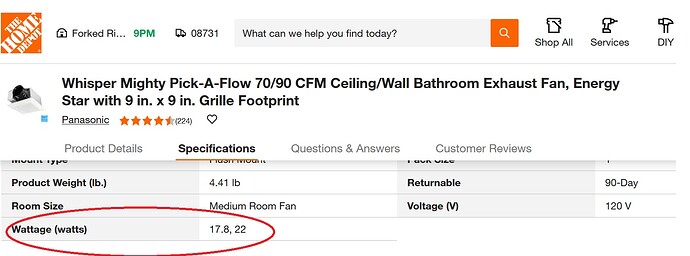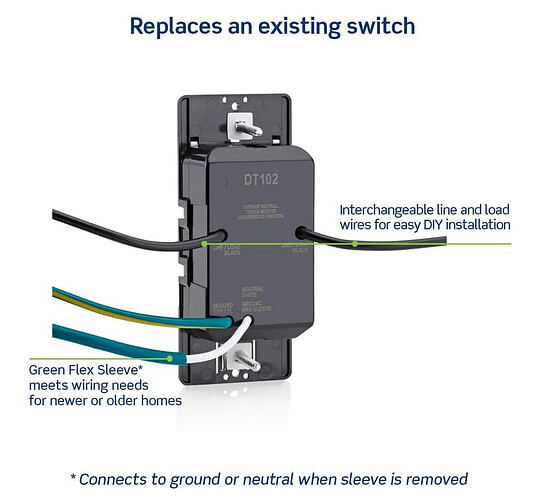It’s too bad you already disco’d the old fan… you could have turned it on, let the wires heat up a bit and then found where they lead with your thermal scope.
How handy are you with the taping tools and mud? You could also cut a small window near, but not at, the ceiling to have more access (you wanna be below the top plate).
Right-angle drills can also come in handy here.
Yeah, I dunno what’s lurking behind the walls. Worst case would be the existing 2 conductor run is stapled all along the studs up the wall, or does a couple 90 degree bends through holes.
I’m hopeful it’s not that bad - the fan in the ceiling is about 1 foot to the left (horizontally only) from the wall switch, so the run should not be that convoluted.
I am planning to cut some extra space in the tile around the switch box (should still be covered by the face plate) to hopefully get some extra peeking space to see what’s up.
Sometimes what you can do is take the old box out to give yourself some room to work. Even if it’s a new work box, you can usually get (beat?) them out with some effort (a sawzall would help). That gives you room to get your hand up there, a flashlight, camera, whatever. When you have the wire sorted you can put back an old work box for the new switch.
My bet, that won’t happen, as the existing wire is stapled to the stud. That is code.
Not really, they used a single run of romex as a switch leg. So, there’s actually power running down the black, through the switch, and back to the fan on the white. That box is missing a neutral.
This is why I mentioned originally that the easiest thing would be to pick up a neutral from any other junction box or fixture in the attic, and snake that down to the existing box, to feed the neutral on the new switch.
I understand the box has power but really it’s a switch leg right now (yes, I am splitting hairs but it doesn’t have a neutral). It has two wires but needs three (hot, neutral, and switch). That’s the extra 120v conductor to which I am referring. I don’t think grabbing any old neutral makes sense unless you know it’s on the same circuit as the fan. Neutrals carry current the same as a hot so if you have a neutral from a different circuit you are a) increasing the load on the circuit (granted, this fan probably isn’t using a ton of current), and b) you still have the issue of having to shut off two circuits to work on it in the future, which I am pretty sure is not code.
I have a fiber optic camera, welcome to use it if you get stuck.
A typical bath fan pulls like 20 watts or so. I doubt it would add any significant load to any neutral circuit.
9 Amps x 120VAC = 1,080 Watts

Yes, I said as much above. Now please address Part B of what I said. I’ll give you a concrete example.
You pull a neutral from a different circuit and run that to some other device that’s getting the hot from a different circuit. Someday down the road you (or better yet, someone else who doesn’t know the history) needs to work on that box and tear apart the neutrals for whatever reason (say they are adding something). Only they don’t know about the second circuit. Someone is using the fan. You just created a shock hazard for the poor SOB taking apart the neutrals because the return of that other circuit is flowing through the neutral that was picked off. What if the neutral gets unknowingly extended, say for a bathroom outlet and someone is running a 1500W hairdryer at the time? Also, what do you do with the black wire on that piece of romex (no such thing as 14-1 romex)? Cap it off? I’d open that box and say “WTF is going on here?” What about on the other end? Same question. Circuits are supposed to be independent entities for reasons such as this.
I have seen this exact scenario above happen as well as others like it (e.g., crossing grounds between two different panels).
Wow, a lot of hypotheticals and speculation there.
What if the circuit he pulls the neutral from is actually the same circuit as the bathroom, since many houses (and specially older houses) group circuits in the same area on the same circuit? Then what?
I am not trying to be a pain but this is not hypothetical at all. I have experienced what I described first hand. While the neutral is close to or at 0v, when you take the neutrals apart you are potentially inserting yourself into the circuit in series, which means you will take on the same current that’s flowing through the circuit. If it’s a lot of current or something inductive (e.g., a motor like a hair dryer) there is also the possibility of an inductive kick as the wires come apart (similar to the clunk you hear when your air conditioner starts up: you can’t change the current across an inductive load instantaneously).
Yes, I suppose in theory you could use just the neutral from the same circuit to avoid what I described. But if you are going to go through all the trouble and need to get a new wire down the wall anyway, why not do it without any questionable practices? Also, I hope you aren’t suggesting running a lonesome bare white wire down the wall.
There’s no lamp in the new fan (I’m guessing they use the same switch/humidity sensor on different models), but regardless I’m pulling a new 14-3 run no matter what.
Following up on this (Yes, honey, I still haven’t finished it):
I enlarged and squared off the existing hole in the wall tile so I could pull the box out and get more access to the wiring run and it’s…not good.
Existing wire is stapled to the wall stud and as far as I can tell it runs straight down the stud and then must go through a hole in the stud farther down than I can see and then do a 180 to get back up to the attic. Where the hole is right now is underneath a window, so I know the wire has to go horizontal somewhere below where I can see in order to get a shot back up to the attic.
I’m thinking instead to run down from the attic into another interior wall where there are existing outlets (and no insulation to push through) to relocate the switch.
Any good ideas for covering up the existing hole in the tiled wall (It’s just about at chest level when seated on the toilet) other than trying to find a matching piece for the existing tile and grouting it in?
So after another trip to the attic, still no good wiring options. My attic HVAC unit basically sits on top of all the interior bathroom walls, blocking access to the top of them to run new wires.
What about this?:
No neutral wire required, I hook it up to the existing 2 wire + ground wiring I already have and wire it in between the line and bathroom fan in the attic?:
Circling back on on this - a variant of the above Leviton switch (with a humidity sensor instead of timers) is exactly what I used and was a great solution.
Had to add a junction box in the attic to handle the connections (line power + double leads from the switch in the wall) and run a short length of romex from the junction box over to the new fan housing.
Other than the short attic romex run from junction box to fan housing, no new wire runs needed.
Fan now turns on either when I turn it on at the switch or it detects humidity from the shower running.

